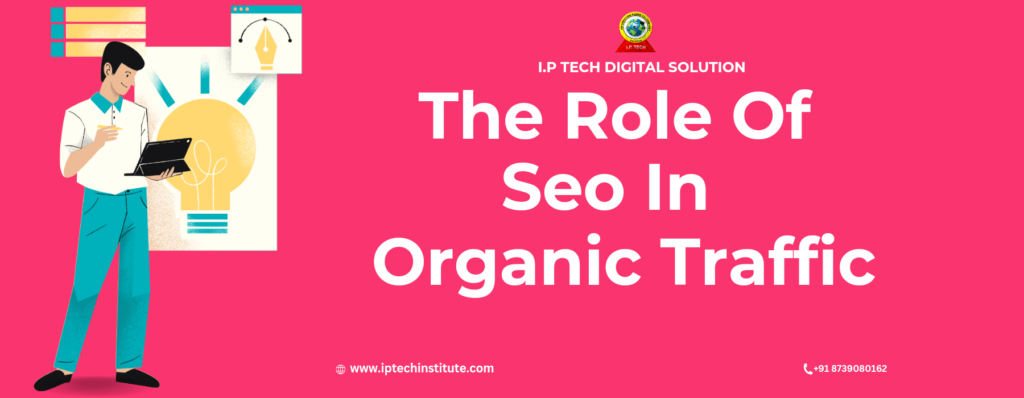Introduction
In the modern digital world, SEO has developed into an important building block for any business desiring enlargement on the internet. This is because over 5 billion searches are made daily on search engines like Google, Bing, and Yahoo. It is, therefore, very important for any business to be able to appear on the front page of the search results if it wants to attract potential customers. While paid ads produce instant traffic, the organic traffic built by effective SEO strategies promises long-term benefits in terms of trust-building and sustainable growth.
This article will try to understand the critical role that SEO plays in driving organic traffic by breaking it down into various aspects that make it indispensable in any digital marketing strategy.

What is SEO?
SEO is the process of optimizing a website or online content for better visibility in search engine results pages. This was to achieve higher positioning for relevant keywords that prospective customers were using to find products, services, or information. The higher one’s rank, the more likely users will click through to one’s website.
SEO isn’t just about filling up your content with a bunch of keywords; it’s on-page and off-page strategies, technical SEO, publishing high-quality content regularly, etc.
Why is Organic Traffic Important?
Organic traffic is just those visitors visiting your site from search results that are organic-meaning unpaid. In contrast to paid traffic driven by ad spending, organic traffic is a more cost-effective and sustainable way to earn users over time.
The advantages of organic traffic will include:
- Cost-effective: Once your website has climbed the ranking ladder, there is no need to continue investing money in ads.
- Credibility: Users are more likely to trust results that are organic rather than paid advertisements.
- Long-term results: SEO would keep generating traffic with no requirement for further investment. On-Page SEO: Optimizing Your Website for Search Engines
- On-page SEO is the process of setting up individual web pages to rank better in the search engines and drive more relevant traffic. Content optimization, optimization of HTML tags, and meta information all form part of this process.
-
Keyword Research and Placement
Keyword research is claimed as the backbone of any SEO campaign that works. Researching high-traffic, low-competition keywords will help drive targeted organic traffic to the website. Identify your keywords; then place them strategically in your:
- Title tags
- Meta descriptions
- Headings
- URLs
- Body content
However, this should not lead to keyword stuffing that may result in penalties. You should integrate the keywords naturally into the content for an easy and smooth reading experience for the users.
-
Optimizing Content
Content is king as far as SEO is concerned. It’s high time to create high-quality, relevant, and very informative content answering user queries. Such search engines are likely to favor long-form articles, blog posts, and guides that comprehensively cover a topic.
Best practices to optimize content include:
- Creating engaging and value-added content.
- Natural usage of the keywords.
- Adding links internally and externally.
- Infographics, images, and videos that enhance user experience.
-
Title Tags and Meta Descriptions
Title tags and meta descriptions help the search engines understand the context of your content. It also contributes to CTR because these elements are the first things users see in SERPs.
Title tags should:
- Below 60 characters
- Should contain target keyword
- It is to be a short description and yet attractive
Meta Description:
- 150-160 characters long
- A short summary of the content containing target keywords
- It must contain a CTA that attracts clicks
Technical SEO: How To Improve Website Performance
While technical SEO tries to improve infrastructural areas which will make the website more easily crawled by search engines, indexed, and ranked, bad technical optimization may be the reason good content doesn’t rank.
-
Mobile Optimization
With the increased use of mobile devices for browsing the net, web pages need to be mobile-friendly. Since most Google search users come through mobile devices, Google mainly indexes the mobile version of any website if available.
To ensure your website is mobile-friendly, keep in mind:
- Use responsive design.
- Optimize images and media to load faster on the mobile screen.
- Ensure clickable elements come out large enough to quickly tap on with a finger against small-sized displays.
-
Page Speed
Page speed is one of the important ranking factors. The pages taking time to load infuriate the users and result in higher bounce rates. You can optimize your page speed by doing the following:
- Image compression
- Browser caching
- Minifying code: It involves HTML, CSS, JavaScript.
-
XML Sitemaps and Robots.txt
An XML sitemap helps a search engine discover what URLs your website has and what structure your site follows, while a robots.txt file communicates which pages a search engine should or shouldn’t crawl.
Both go hand in hand to ensure that all your pages are findable and crawlable by search engines.
Off-Page SEO: Building Credibility and Trust
Off-page SEO is anything done outside of your website to help it rank better in the search engine results pages. It is all about the credibility and authority of your site.
-
Building Backlinks
Among the most critical off-page SEO factors comes in the form of backlinks or incoming links from other reputable sites. Quality backlinks are essentially votes of confidence by other sites to the search engines that your content is credible and worthy of being ranked highly for more people to see and use.
Means to get backlinks:
- Guest blogging.
- Reaching out to industry influencers.
- Creating shareable content; for example, infographics.
-
Social Media Signals
Although not a direct ranking factor, social media indirectly influences SEO: through more efficient user engagement on Facebook, Instagram, and Twitter, it will further increase the visibility of content and drive traffic to your website.
-
Brand Mentions and Reviews
Search engines like websites that possess a good reputation. Positive reviews and brand mentions on the web go a long way in building up trust and authority. You can make your local SEO even more effective by encouraging your happy customers to leave reviews on Google My Business and similar platforms.
Local SEO: Bringing in Traffic from Regions
If your business operates in a certain geographical location, then local SEO is absolutely necessary to capture customers from around your area. It optimizes your website for local searches to come up whenever customers around your area are looking for the services you offer.
-
Google My Business Optimization
To any local business, a fully optimized Google My Business listing is one of the most important elements. For this reason, it is important that your GMB profile contains:
- Accurate NAP information.
- High-quality images of your business.
- Updated business hours and contact information.
-
Local Keywords
Use location-based keywords in the content of your website for better visibility in local search results. So, instead of targeting “best Italian restaurant,” you can target “best Italian restaurant in New York City.”
Content Marketing Supports SEO:
Content marketing and SEO are closely intertwined. Quality, relevant, and captivating content will help you build the authority of your site and attract more organic traffic. Below are some of the content strategies that support SEO.
-
Blogging
Writing and publishing regular insight and information on the blog increases keyword rankings. Ensure that each blog post is optimized for target keywords and contains internal links to other relevant pages.
-
Long-Form Content
Longer articles, usually those over 2,000 words, have a higher ranking because they can bring more value to the user. Your objective, then, should be the creation of long guides, case studies, and tutorials that will serve as the resource of choice for your audience.
-
Multimedia Content
Images, videos, infographics, and podcasts add variety and interactivity to your content. This in turn improves user experience, moving you closer to the prospect of backlinks to your website.
Conclusion: Why SEO is Key to Organic Traffic Driving
On this particular note, SEO acts very importantly while driving organic traffic onto your website. Paying attention to on-page SEO, technical SEO, off-page SEO, and content marketing are some of the ways that can guarantee higher search engine rankings and drive more traffic to your site. Organic traffic does not only save money from expensive advertisements but also builds trust and leads to long-term success in business. SEO is the most sustainable way of growing your online presence toward the fruition of your business goals, provided you use the proper strategies to accomplish it.
